Are you curious about the calories in wings and things? Join me as we delve into the nutritional information for your favorite dishes.
Discovering the calories in wings and other chicken cuts can help you make informed choices about your meals. Chicken breast is a popular low-fat option, with 284 calories per 3.5-ounce serving. Chicken thigh has slightly more calories at 208 per serving, while chicken wings have 43 calories per wing. Chicken drumsticks contain 149 calories per serving. It’s important to note that these calorie counts change when you include the skin. Cooking methods also affect the calorie content, with options like grilling or baking being lower in calories than frying. Remember to consider any allergies or dietary restrictions when enjoying chicken dishes.
Key Takeaways:
- Knowing the calorie content of wings and things can help you make informed decisions about your meals.
- Chicken breast is a low-fat option with 284 calories per 3.5-ounce serving.
- Chicken thigh has slightly more calories at 208 per serving.
- Chicken wings have 43 calories per wing.
- Chicken drumsticks contain 149 calories per serving.
Understanding the Calorie Content of Chicken Cuts
Before we dive into the specifics of wings, let’s understand the calorie content of various chicken cuts. Knowing the nutritional information for wings, along with other chicken cuts, will help you make informed choices about your meals.
Chicken breast is a popular low-fat option, with only 284 calories per 3.5-ounce serving. It’s lean and packed with protein, making it a healthy choice for those watching their calorie intake. On the other hand, chicken thigh has slightly more calories, with 208 calories per serving. While it contains a bit more fat than chicken breast, it offers a richer flavor that many people enjoy.
When it comes to chicken wings, they have about 43 calories per wing. However, it’s important to note that these calorie counts can change when you include the skin. The presence of skin can increase the calorie content significantly. So, if you’re looking for a lower-calorie option, you may consider removing the skin before indulging in this delicious snack.
Additionally, cooking methods can also impact the calorie content of wings and other chicken cuts. Grilling or baking chicken is generally lower in calories compared to frying. These methods allow the excess fat to drip away, resulting in a healthier option. So, next time you’re preparing wings or other chicken dishes, consider these cooking methods to cut down on unnecessary calories.
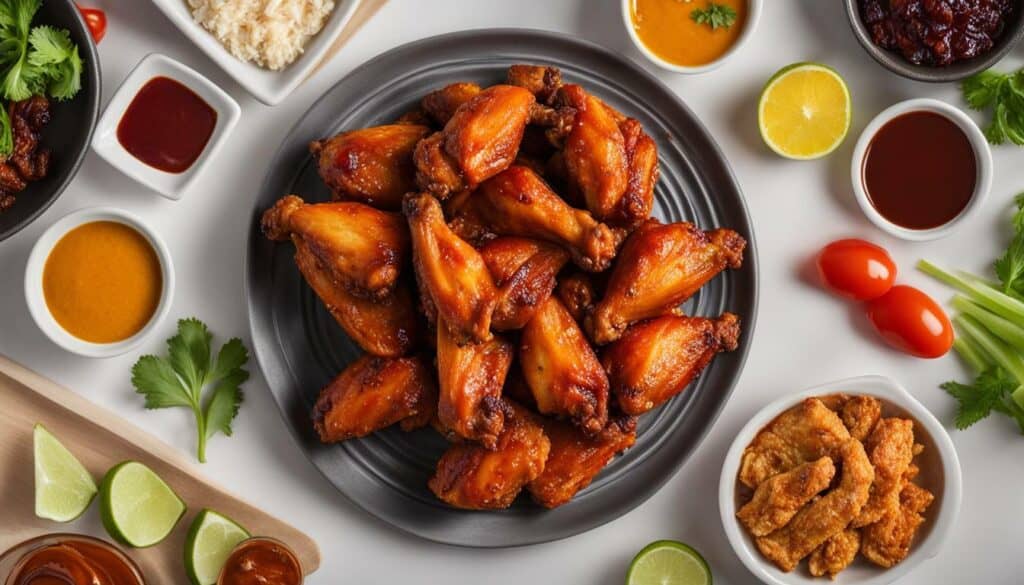
- Chicken breast contains 284 calories per 3.5-ounce serving and is a popular low-fat option.
- Chicken thigh has 208 calories per serving and offers a richer flavor.
- Chicken wings have about 43 calories per wing, but the calorie count increases with the presence of skin.
- Grilling or baking chicken is a healthier cooking method compared to frying, reducing calorie intake.
| Chicken Cut | Calories per Serving |
|---|---|
| Chicken Breast | 284 |
| Chicken Thigh | 208 |
| Chicken Wings | 43 (without skin) |
Wings: A Low-Calorie Option
Chicken wings are a crowd favorite, but are they as calorically dense as you think? Let’s dive into the wings nutrition facts to find out. A single chicken wing has only 43 calories, making it a relatively low-calorie choice for those watching their intake. However, it’s important to note that this calorie count is for a plain, unseasoned wing without the skin.
If you prefer your wings with the skin on, the calorie content increases. The skin adds an additional 30-35 calories per wing, bringing the total to around 73-78 calories per wing. That means if you enjoy a plate of six wings with the skin on, you would be consuming approximately 438-468 calories. It’s worth keeping in mind if you’re trying to manage your calorie intake.
To put it into perspective, let’s compare the calorie content of wings to other chicken cuts. A 3.5-ounce serving of skinless chicken breast contains approximately 284 calories, making it a popular low-fat option. Chicken thigh, on the other hand, has slightly more calories at 208 per serving. Chicken drumsticks, known for their flavorful meat, contain about 149 calories per serving.
| Chicken Cut | Calories per Serving (3.5 oz) |
|---|---|
| Skinless Chicken Breast | 284 |
| Chicken Thigh | 208 |
| Chicken Wings (without skin) | 43 |
| Chicken Drumsticks | 149 |
It’s important to remember that cooking methods also play a role in the calorie content of your wings and other chicken dishes. Grilling or baking your chicken is a healthier option compared to frying, as it helps to reduce the overall calorie count. By opting for these cooking methods, you can enjoy your wings guilt-free without compromising on flavor.
When indulging in wings and things, it’s crucial to consider any allergies or dietary restrictions you or your dining companions may have. Always check with the restaurant or read the menu carefully to ensure there are no hidden ingredients that could potentially cause harm or discomfort.
So, whether you’re a fan of chicken wings or prefer other cuts, understanding the calories in chicken wings and things can help you make informed decisions about your meals. When consumed in moderation and prepared with healthier cooking methods, wings can be a delicious and relatively low-calorie option. Just remember to mind the skin and consider any personal dietary needs. Enjoy your wings responsibly!
The Calorie Content of Different Chicken Cuts
Exploring Other Chicken Cuts
Wings aren’t the only chicken cut you’ll find in wings and things menus. Let’s explore other options. When it comes to calories, chicken breast is a popular low-fat choice. A 3.5-ounce serving of chicken breast contains approximately 284 calories. This lean cut is not only delicious but also a great source of protein.
If you prefer something slightly richer in flavor, chicken thigh is another commonly used cut. A serving of chicken thigh, with the skin removed, contains about 208 calories. It offers a good balance between taste and nutritional value.
Now let’s talk about everyone’s favorite finger food – chicken wings! With an average of 43 calories per wing, they are a relatively low-calorie option. However, keep in mind that this estimate is for plain, unseasoned wings without sauce. The calorie count can increase significantly depending on the cooking method and the sauces or dips you choose.
If you’re looking for something with a bit more meat on the bone, chicken drumsticks are a flavorful choice. A serving of drumsticks, with the skin removed, contains approximately 149 calories. They are perfect for those who enjoy a balance between taste and convenience.
To summarize, here’s a table showcasing the approximate calorie content of various chicken cuts commonly found in wings and things menus:
| Chicken Cut | Calories per Serving (3.5 oz) |
|---|---|
| Chicken Breast | 284 |
| Chicken Thigh | 208 |
| Chicken Wing | 43 |
| Chicken Drumstick | 149 |
It’s important to note that these calorie counts are based on the chicken cuts without the skin. When the skin is included, the calorie content will increase. Additionally, cooking methods play a role in the calorie count as well. Grilling or baking the chicken cuts will generally result in lower calorie counts compared to frying. So, if you’re conscious about your calorie intake, consider opting for the healthier cooking methods.
Lastly, it’s always good to consider any allergies or dietary restrictions when enjoying wings and things. If you or someone in your party has specific dietary needs, make sure to communicate them with the restaurant staff. Many establishments offer alternative options or can accommodate specific requests to ensure everyone can enjoy a delicious meal.
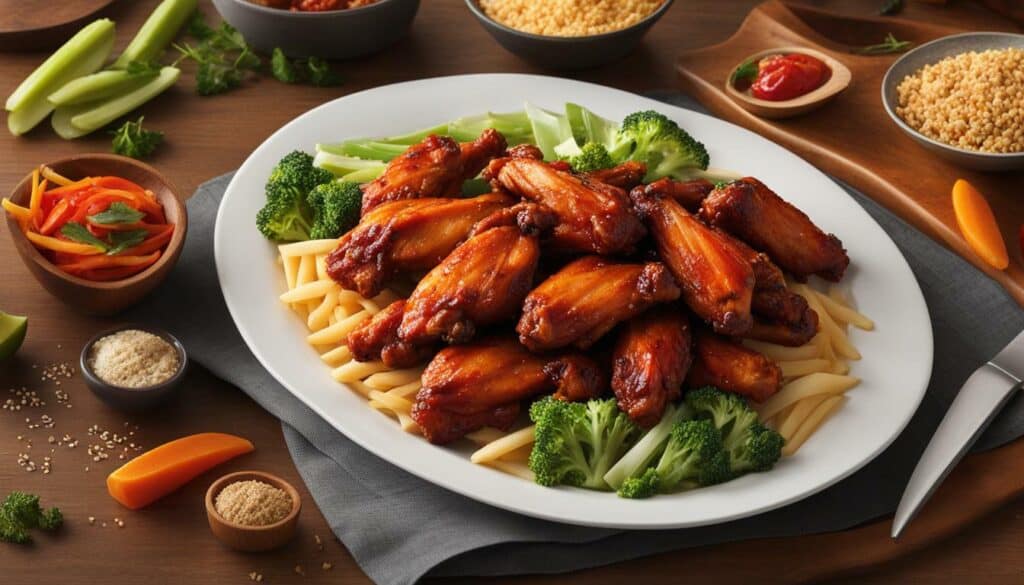
You might be surprised to learn that the way chicken is prepared and cooked can impact its calorie count. When it comes to wings and things, the presence of skin and the cooking methods used can make a significant difference in the overall calorie content.
First, let’s talk about the skin. Chicken skin is high in fat, so removing it can significantly reduce the calorie count of your meal. For example, a skinless chicken wing has about 43 calories, while a wing with skin can have around 61 calories. So if you’re looking to keep the calorie count low, opting for skinless wings is a smart choice.
Cooking methods also play a role in determining the calorie content. Frying chicken wings, for instance, can increase their calorie count due to the added oil. On the other hand, grilling or baking wings can help reduce the calorie content, as less oil is used in the cooking process. By choosing healthier cooking methods, you can enjoy wings and things without compromising on taste or nutrition.
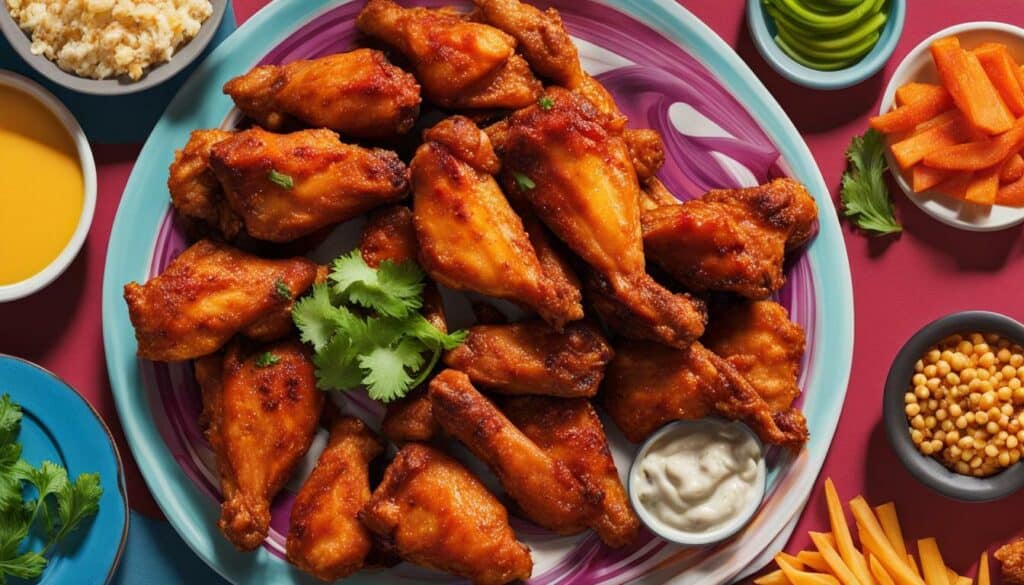
As shown in the table below, different cooking methods can have a significant impact on the calorie content of wings and things:
| Cooking Method | Calories per Serving |
|---|---|
| Fried | 175 |
| Grilled | 120 |
| Baked | 105 |
As you can see, choosing grilled or baked wings can save you calories compared to their fried counterparts. So the next time you’re craving some wings and things, consider the cooking method and opt for a healthier choice!
Chicken Breast: A Low-Fat Option
If you’re looking for a healthier choice, chicken breast might be the way to go. With only 284 calories per 3.5-ounce serving, it is a popular low-fat option for wings and things dishes. Not only is it low in calories, but it also packs a punch in terms of protein content, making it a satisfying and nutritious choice.
When enjoying chicken breast, it’s important to note that the calorie count can vary depending on how it’s prepared. Grilling or baking chicken breast without the skin significantly reduces the calorie content, making it an even better option for those watching their calorie intake. However, if you prefer a crispy skin, it’s important to keep in mind that the calorie count will increase.
For a visual representation of the calorie content in different chicken cuts, take a look at the table below:
| Chicken Cut | Calories per Serving (3.5 ounces) |
|---|---|
| Chicken Breast | 284 |
| Chicken Thigh | 208 |
| Chicken Wings | 43 |
| Chicken Drumsticks | 149 |
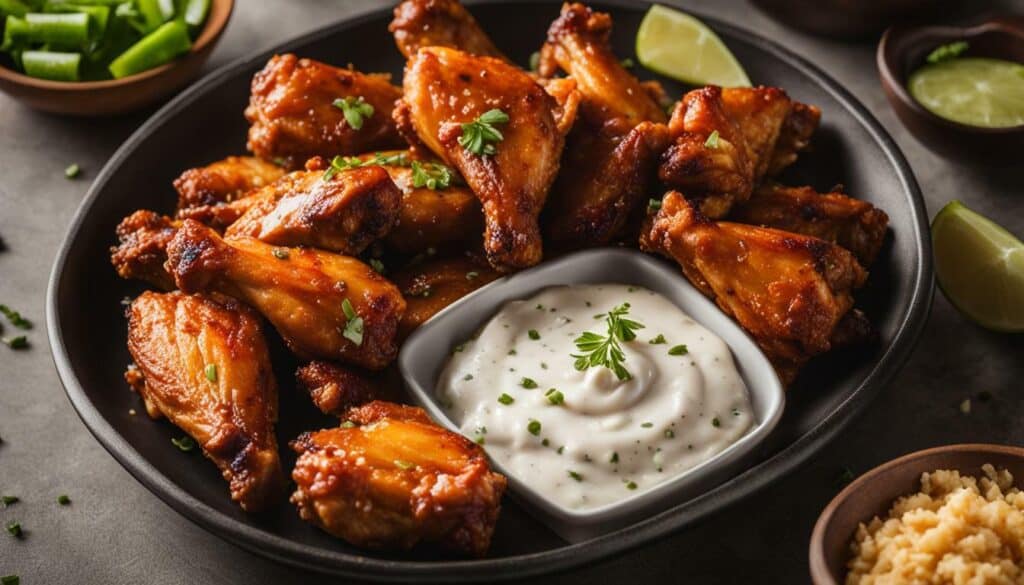
Remember, making informed decisions about your meals is crucial for maintaining a balanced diet. By understanding the nutritional information for wings and other chicken cuts, you can tailor your choices to suit your dietary goals and preferences. Whether you opt for the lean chicken breast or indulge in the flavorful chicken thigh, always consider any allergies or dietary restrictions to ensure an enjoyable and safe dining experience.
Chicken Thigh: Slightly Higher in Calories
Chicken thigh offers a different taste and texture, but does it come with a higher calorie count? Let’s take a closer look at the nutritional value of chicken thigh in comparison to other chicken cuts commonly used in wings and things dishes.
When it comes to calorie content, chicken thigh has slightly more calories compared to chicken breast and chicken wings. A 3.5-ounce serving of chicken thigh contains approximately 208 calories, making it a slightly higher calorie option. However, it is important to note that the calorie content can vary depending on the cooking method and whether or not the skin is included.
To provide some context, a serving of skinless chicken breast contains around 284 calories, while a single chicken wing has approximately 43 calories. Chicken drumsticks, on the other hand, contain about 149 calories per serving. These numbers indicate that chicken thigh falls somewhere in between chicken breast and chicken drumsticks in terms of calorie content.
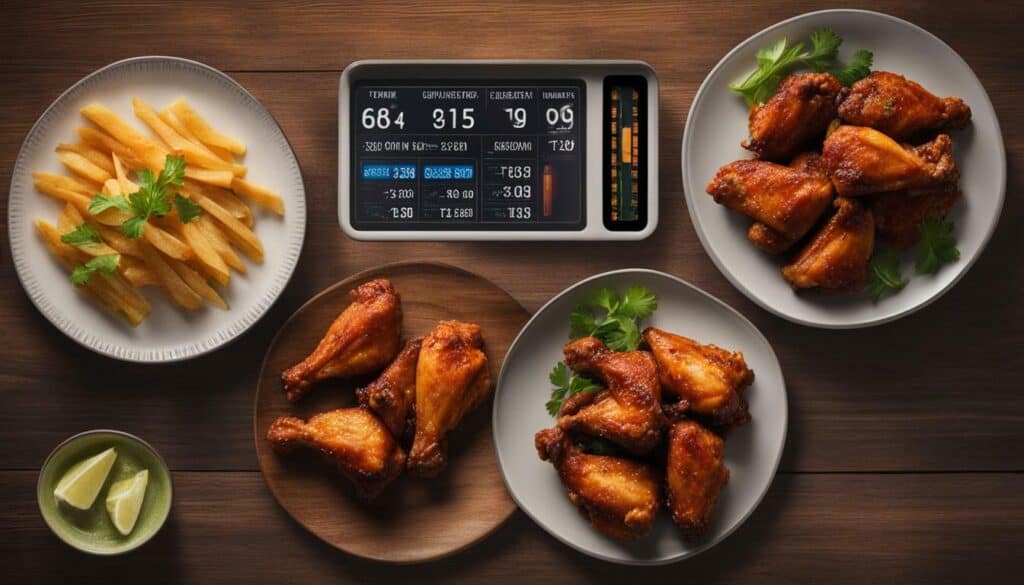
When it comes to cooking methods, grilling or baking chicken thigh can be a healthier option compared to frying, as it reduces the calorie content. Additionally, removing the skin from chicken thigh can significantly decrease the overall calorie count.
When enjoying wings and things dishes, it is always important to consider any allergies or dietary restrictions. Whether you prefer the slightly higher calorie count of chicken thigh or opt for the low-fat choice of chicken breast, understanding the nutritional value of different chicken cuts can help you make informed decisions about your meals.
Chicken Drumsticks: A Mid-Calorie Option
If you prefer dark meat, chicken drumsticks might be your go-to option. These flavorful cuts are a popular choice on the wings and things menu. When it comes to calories, chicken drumsticks fall in the mid-range, offering a satisfying meal without excessive calorie intake.
On average, a 3.5-ounce serving of chicken drumsticks contains approximately 149 calories. However, it’s important to note that the calorie count can vary depending on factors such as cooking methods and whether or not the skin is included. To keep the calorie content lower, opt for skinless drumsticks and choose healthier cooking methods like grilling or baking.
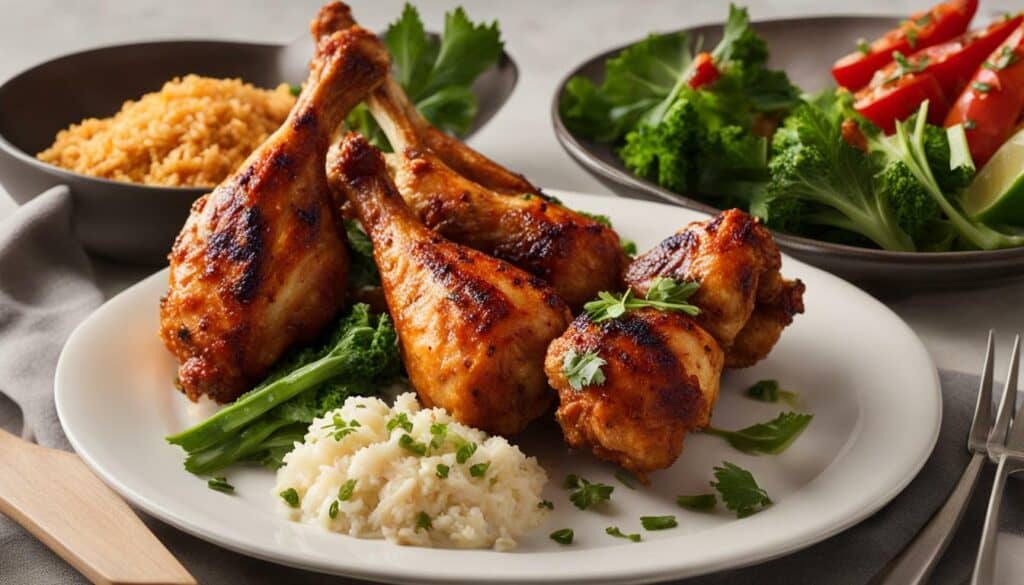
Here’s a table summarizing the nutritional value of chicken drumsticks:
| Chicken Drumsticks | Calories per Serving (3.5 oz) |
|---|---|
| Skinless, Grilled/Baked | 149 |
| Skin-on, Grilled/Baked | 175 |
| Skinless, Fried | 196 |
| Skin-on, Fried | 218 |
When enjoying chicken drumsticks as part of your wings and things meal, always consider any allergies or dietary restrictions you or your dining companions may have. With their delicious taste and moderate calorie content, chicken drumsticks can be a satisfying choice for those who prefer dark meat.
Considering Allergies and Dietary Restrictions
Before indulging in your favorite wings and things, it’s essential to consider any allergies or dietary restrictions you may have. While chicken is a versatile protein choice, there are some factors to keep in mind to ensure a safe and enjoyable dining experience. Whether you have food allergies, follow a specific diet, or have religious or cultural dietary restrictions, it’s important to communicate your needs to the restaurant staff and make informed choices.
If you have allergies, be cautious about cross-contamination. Many establishments that serve wings and things also offer other dishes that may contain allergens such as nuts, dairy, or gluten. Ensure that the kitchen staff is aware of your allergies and request dedicated equipment or separate preparation areas if necessary. It’s also advisable to ask about the ingredients in sauces and marinades, as they may contain hidden allergens.
For those following specific diets, such as vegetarian or vegan, wings and things may not be the ideal choice. Traditional wings are made from chicken, which doesn’t align with these dietary preferences. However, some restaurants offer plant-based alternatives, such as cauliflower or tofu wings. These options can provide a similar texture and flavor experience without compromising dietary choices.
Religious or cultural dietary restrictions should also be taken into account. Some individuals may need to adhere to specific guidelines related to the preparation or consumption of certain foods. If you require halal, kosher, or any other specific dietary requirements, it’s crucial to find a restaurant that caters to those needs. Additionally, understanding the cooking methods, ingredients, and sourcing practices can help in making an informed decision that aligns with your beliefs.
Remember, communication is key when it comes to allergies and dietary restrictions. Don’t hesitate to ask questions, notify the staff about your specific needs, and verify the ingredients used in the dishes you wish to enjoy. By doing so, you can ensure a safe and satisfying dining experience while savoring your favorite wings and things.
Understanding the calorie content of wings and things can help you make healthier choices while still enjoying your favorite foods. Whether you’re a fan of chicken wings, drumsticks, breasts, or thighs, being aware of the calorie counts can assist you in making informed decisions about your meals.
When it comes to calorie-conscious options, chicken breast is a standout choice. With only 284 calories per 3.5-ounce serving, it provides a low-fat, high-protein option for wings and things enthusiasts. Chicken thigh, on the other hand, offers slightly more calories at 208 per serving but is still a flavorful alternative.
For those who love traditional chicken wings, you’ll be pleased to know that they are relatively low in calories, with only 43 calories per wing. However, keep in mind that these numbers can vary depending on the presence of skin and cooking methods.
Chicken drumsticks are another popular choice among wings and things lovers. With 149 calories per serving, they provide a mid-calorie option that satisfies your cravings.
Remember, when enjoying wings and things, it’s essential to consider any allergies or dietary restrictions you may have. This way, you can fully enjoy your meal while staying mindful of your health and well-being.
So, the next time you’re perusing the menu at your favorite wing joint, take a moment to consider the calorie content of the different chicken cuts. Armed with this knowledge, you can make choices that align with your health goals without sacrificing taste and enjoyment.
FAQ
Q: What is the calorie content of chicken breast?
A: Chicken breast has 284 calories per 3.5-ounce serving.
Q: How many calories are in chicken thigh?
A: Chicken thigh contains 208 calories per serving.
Q: How many calories are in a chicken wing?
A: Chicken wings have 43 calories per wing.
Q: What is the calorie content of chicken drumsticks?
A: Chicken drumsticks contain 149 calories per serving.
Q: Does the calorie count change when including the skin?
A: Yes, including the skin can increase the calorie content.
Q: Do cooking methods affect the calorie content?
A: Yes, grilling or baking wings generally have fewer calories compared to frying.
Q: What should I consider regarding allergies or dietary restrictions?
A: It’s important to consider any allergies or dietary restrictions when enjoying chicken dishes.
How Many Calories are in BBQ Chicken Wings Compared to Other Wing Varieties?
When it comes to calories in bbq chicken wings, they typically contain about 100 to 150 calories per wing, depending on the size and preparation method. Compared to other wing varieties like buffalo or fried wings, BBQ chicken wings usually have slightly fewer calories. However, it’s important to note that these numbers can vary based on the specific recipe and cooking techniques used.

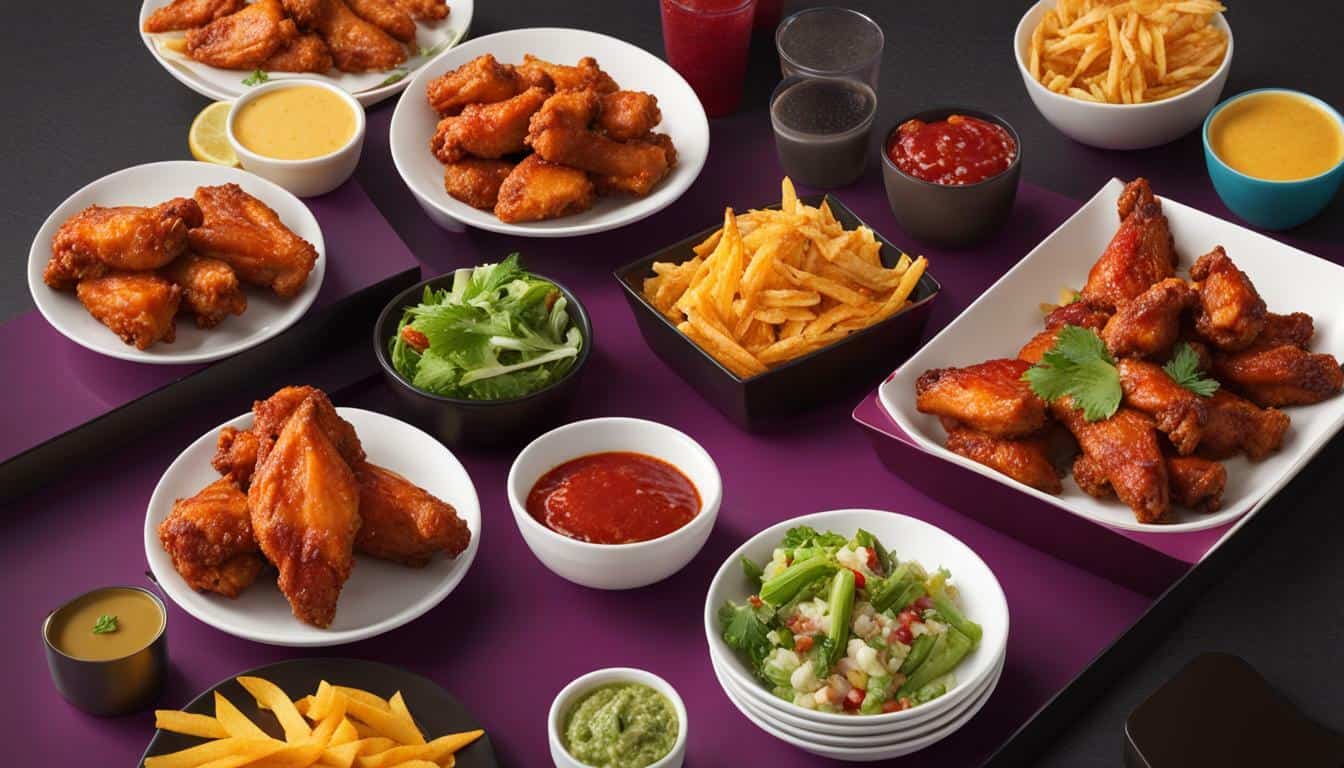



Leave a Reply